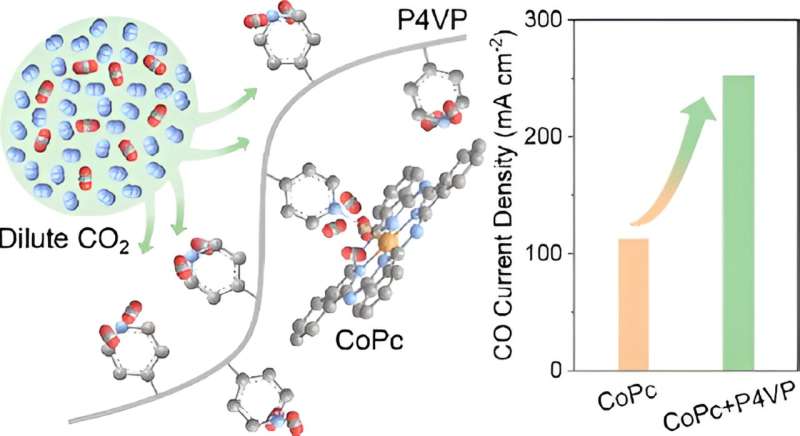This article has been reviewed according to Science X's editorial process and policies. Editors have highlighted the following attributes while ensuring the content's credibility:
fact-checked
peer-reviewed publication
trusted source
proofread
New strategy boosts direct electrolysis of dilute carbon dioxide

Converting carbon dioxide (CO2) from industrial point sources to chemicals and fuels utilizing renewable energy can help to tackle the climate crisis. CO2 electrolysis is one promising route.
Previous studies were generally performed with pure or highly concentrated CO2 feeds, while the CO2 concentration in flue gas from the combustion of fossil fuels was very low, typically from 5% to 15%. The energy and capital costs associated with capturing and purifying CO2 from flue gas point sources are very high. The direct utilization of industrial flue gas bypassing the capture and purification steps for producing pure CO2 feeds is still challenging.
Recently, a research team led by Profs. Wang Guoxiong and Gao Dunfeng from the Dalian Institute of Chemical Physics (DICP) of the Chinese Academy of Sciences (CAS), in collaboration with Prof. An Qingda from the Dalian Polytechnic University, have proposed a molecular enhancement strategy for direct electrolysis of dilute CO2 to CO. This study was published in ACS Energy Letters.
To deal with the unfavorable mass transport, reaction thermodynamics, and kinetics of direct electrolysis of dilute CO2, the researchers constructed reaction microenvironment surrounding catalytically active sites by molecularly modifying CoPc electrodes with a poly(4-vinylpyridine) (P4VP) molecule. The formed reaction microenvironment effectively integrated the capture and conversion of CO2 from dilute feed streams.
With a home-made alkaline membrane electrode assembly (MEA) electrolyzer, the researchers obtained a remarkable CO partial current density of 252 mA cm-2 with a CO Faradaic efficiency of 90% under the dilute feed with a typical CO2 concentration (10%) in flue gas, which was 2.24-fold higher than that of bare CoPc electrode.
Physicochemical and electrochemical structural characterization results indicated that the abundant pyridine groups of the P4VP modifier improved sequentially the physical adsorption and chemical activation of CO2 over Co sites of CoPc catalysts, resulting in the impressive performance for direct electrolysis of dilute CO2 to CO.
This molecular enhancement strategy, with further precise control in catalyst structures and reaction microenvironments, will hold great promise for the direct electrolysis of industrial flue gas and the selective production of multicarbon chemicals such as ethylene.
More information: Bingyu Chen et al, Molecular Enhancement of Direct Electrolysis of Dilute CO2, ACS Energy Letters (2024). DOI: 10.1021/acsenergylett.3c02812
Journal information: ACS Energy Letters
Provided by Chinese Academy of Sciences





















